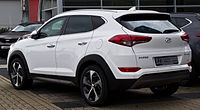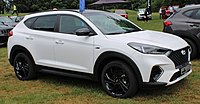Hyundai Tucson
| Hyundai Tucson | |
|---|---|
| Production period: | 2004–2010, since 2015 |
| Class : | SUV |
| Body versions : | Station wagon |
| Successor: | Hyundai ix35 (2009-2015) |
The Hyundai Tucson is a sports utility vehicle from the Hyundai brand introduced in August 2004 , which was replaced by the ix35 in 2009 . With a length of approx. 4.30 m and a list price from 19,890 € (as of August 2008), the Hyundai Tucson is one of the inexpensive compact SUVs. The vehicle was available with both front-wheel and all-wheel drive. It shares the technical basis with the Kia Sportage . The cars are now sold worldwide under the Tucson name.
First generation (JM, 2004–2010)
| 1st generation | |
|---|---|
|
Hyundai Tucson (2005-2010) |
|
| Production period: | 2004-2010 |
| Body versions : | Station wagon |
| Engines: |
Otto engines : 2.0–2.7 liters (104–129 kW) Diesel engines : 2.0 liters (83–104 kW) |
| Length: | 4325 mm |
| Width: | 1795 mm |
| Height: | 1730 mm |
| Wheelbase : | 2630 mm |
| Empty weight : | 1537-1848 kg |
Engines
| model | Displacement | cylinder | Power at 1 / min |
Torque at 1 / min |
Consumption according to ECE | drive | construction time |
|---|---|---|---|---|---|---|---|
| Petrol engines | |||||||
| 2.0 | 1975 cc | 4th | 104 kW (141 PS) / 6000 | 184 Nm / 4500 | 8.0-8.2 l / 100 km | 2WD / 4WD | 08 / 2004–03 / 2010 |
| 2.7 V6 | 2656 cc | 6th | 129 kW (175 PS) / 6000 | 241 Nm / 4000 | 10.0 l / 100 km | 4WD | 08 / 2004–03 / 2010 |
| Diesel engines | |||||||
| 2.0 CRDi | 1991 cc | 4th | 83 kW (113 PS) / 4000 | 245 Nm / 1800-2500 | 7.0-8.0 l / 100 km | 2WD / 4WD | 08 / 2004–01 / 2006 |
| 2.0 CRDi VGT | 1991 cc | 4th | 103 kW (140 PS) / 4000 | 305 Nm / 1800-2500 | 7.0-8.0 l / 100 km | 2WD / 4WD | 01 / 2006-10 / 2008 |
| 2.0 CRDi | 1991 cc | 4th | 110 kW (150 PS) / 3800 | 305 Nm / 1800-2500 | 7.1-7.5 l / 100 km | 2WD / 4WD | 11/2008 - 03/2010 |
Third generation (TL, 2015–)
| 3rd generation | |
|---|---|
|
Hyundai Tucson (2015-2018) |
|
| Production period: | since 2015 |
| Body versions : | Station wagon |
| Engines: |
Gasoline engines : 1.6 liters (97–130 kW) Diesel engines : 1.6–2.0 liters (85–136 kW) |
| Length: | 4475 mm |
| Width: | 1850 mm |
| Height: | 1645 mm |
| Wheelbase : | 2670 mm |
| Empty weight : | 1454-1690 kg |
| Stars in the Euro NCAP - Crash Test (2015) |
|
The third generation was presented at the Geneva Motor Show 2015. The car replaces the Hyundai ix35 worldwide and has been available since the second half of 2015.
The new Tucson is 1.65 meters high, 1.85 meters wide and 4.47 meters long. It has a load volume of 513 liters - a maximum of 1,503 liters (if the rear seats are folded forward). The vehicle is closely related to the 4th generation Kia Sportage .
The car is available in four equipment lines. The entry-level version is the ' Classic' version, which comes with LED daytime running lights, air conditioning and audio systems including a Bluetooth hands-free system as standard. The ' trend' offers more comfort , for example, with automatic climate control, heated steering wheel, heated seats in the front or parking aid in the rear. External distinguishing features are roof rails and underrun protection, fog lights and LED taillights. The ' Style' equipment variant features front and rear parking assistance, a reversing camera, rain sensor, automatically dimming rear-view mirror or radio navigation system.
In the summer of 2018, the Tucson underwent a facelift. The sporty N-Line equipment variant has been available since spring 2019 .
Technical specifications
Petrol engines
| Parameters | blue 1.6 GDI | 1.6 GDI | 1.6 T -GDI | 1.6 T -GDI all-wheel drive | ||
|---|---|---|---|---|---|---|
| Construction period | 07 / 2015–07 / 2018 | since 07/2018 | 07 / 2015–07 / 2018 | since 07/2018 | 07 / 2015–07 / 2018 | since 07/2018 |
| Engine characteristics | ||||||
| Engine type | R4 petrol engine | |||||
| Mixture preparation | Direct injection | |||||
| Engine charging | - | turbocharger | ||||
| Displacement | 1591 cc | |||||
| Max. power | 97 kW (132 PS) at 6300 rpm |
130 kW (177 hp) at 5500 rpm |
||||
| Max. Torque | 161 Nm at 4850 rpm |
265 Nm at 1500-4500 rpm |
||||
| Power transmission | ||||||
| Drive, as standard | Front wheel drive | all wheel drive | ||||
|
Gearbox, as standard [optional] |
6-speed manual transmission | 6-speed manual transmission [7-speed dual clutch transmission] |
||||
| Readings | ||||||
| Top speed | 182 km / h | 205 km / h [201 km / h] |
202 km / h [201 km / h] |
|||
|
Acceleration, 0-100 km / h |
11.5 s | 9.2 s [8.9 s] |
9.5 s [9.1 s] |
|||
|
Fuel consumption over 100 km (combined) |
6.3 l super | 7.2 l super | 7.3 l super [7.1 l super] |
7.4 l super [6.9 l super] |
7.6 l super [7.5 l super] |
7.8 l super [7.4 l super] |
|
CO 2 emissions (combined) |
147 g / km | 165 g / km | 169 g / km [165 g / km] |
170 g / km [157 g / km] |
177 g / km [175 g / km] |
179 g / km [169 g / km] |
| Tank capacity | 62 l | |||||
|
Emission standard according to EU classification |
Euro 6 | Euro 6d-TEMP | Euro 6 | Euro 6d-TEMP | Euro 6 | Euro 6d-TEMP |
Diesel engines
| Parameters | 1.6 CRDi | blue 1.7 CRDi | blue 2.0 CRDi | 2.0 CRDi | |||||
|---|---|---|---|---|---|---|---|---|---|
| Construction period | since 07/2018 | 07 / 2015–07 / 2018 | 04/2016–07/2018 | 07 / 2015–07 / 2018 | since 07/2018 | ||||
| Engine characteristics | |||||||||
| Engine type | R4 diesel engine | ||||||||
| Mixture preparation | Common rail direct injection | ||||||||
| Engine charging | turbocharger | ||||||||
| Displacement | 1598 cc | 1685 cc | 1995 cc | ||||||
| Max. power | 85 kW (116 PS) at 4000 rpm |
100 kW (136 hp) at 2750-4000 rpm |
85 kW (116 PS) at 4000 rpm |
104 kW (141 hp) at 4000 rpm |
100 kW (136 hp) at 2750-4000 rpm |
136 kW (185 PS) at 4000 rpm |
136 kW (185 hp) at 2750-4000 rpm |
||
| Max. Torque | 280 Nm at 1500-2750 rpm |
320 Nm at 2000-2250 rpm |
280 Nm at 1250-2500 rpm |
340 Nm at 1750-2500 rpm |
373 Nm at 1500-2500 rpm |
400 Nm at 1750-2750 rpm |
|||
| Power transmission | |||||||||
| Drive, as standard | Front wheel drive | all wheel drive | Front wheel drive | all wheel drive | |||||
|
Gearbox, as standard [optional] |
6-speed manual transmission | 6-speed manual transmission [7-speed dual clutch transmission] |
6-speed manual transmission | 7-speed dual clutch transmission | 6-speed manual transmission | 6-speed manual transmission [6-speed automatic transmission] |
6-speed manual transmission [8-speed automatic transmission] |
||
| Readings | |||||||||
| Top speed | 175 km / h | 180 km / h [180 km / h] |
176 km / h | 185 km / h | 186 km / h | 184 km / h [184 km / h] |
201 km / h [201 km / h] |
||
|
Acceleration, 0-100 km / h |
11.8 s | 11.2 s [11.8 s] |
11.4 s [12.0 s] |
13.7 s | 11.5 s | 10.6 s | 10.9 s [12.0 s] |
9.9 s [9.5 s] |
|
|
Fuel consumption over 100 km (combined) |
5.0 l diesel | 5.0 l diesel [4.9 l diesel] |
5.2 l diesel [5.2 l diesel] |
4.6 l diesel | 4.9 l diesel | 4.8 l diesel | 5.2 l diesel [6.0 l diesel] |
5.9 l diesel [6.5 l diesel] |
5.4 l diesel [5.8 l diesel] |
|
CO 2 emissions (combined) |
132 g / km | 132 g / km [129 g / km] |
138 g / km [138 g / km] |
119 g / km | 129 g / km | 127 g / km | 139 g / km [160 g / km] |
154 g / km [170 g / km] |
142 g / km [153 g / km] |
| Tank capacity | 62 l | ||||||||
|
Emission standard according to EU classification |
Euro 6d-TEMP | Euro 6 | Euro 6d-TEMP | ||||||
Registration numbers
In 2016, 25,494 Tucson cars were registered in the Federal Republic of Germany - 11,883 of them with diesel drive and 11,249 with all-wheel drive. In 2017 there were 23,645 models - 6,949 of them with diesel drive and 7,544 with all-wheel drive, in 2018 24,055 Tucson - of which 2,786 with diesel drive and 5,410 with all-wheel drive and in 2019 24,395 vehicles - of which 2,117 with diesel drive and 6,826 with all-wheel drive.
Web links
Individual evidence
- ↑ Result of the Hyundai Tucson in the Euro NCAP crash test (2015)
- ↑ http://www.autobild.de/artikel/hyundai-tucson-autosalon-genf-2015-sitzprobe-5602146.html
- ↑ Report on autobild.de
- ↑ Report on auto-motor-und-sport.de
- ↑ New registrations of passenger cars in December 2016 by brand and model series. Retrieved December 7, 2017 .
- ↑ New registrations of passenger cars in December 2017 by brand and model series. Retrieved January 9, 2018 .
- ↑ New registrations of passenger cars in December 2018 by brand and model series. Retrieved January 18, 2018 .
- ↑ New registrations of passenger cars in December 2019 by brand and model series. Retrieved January 11, 2019 .










